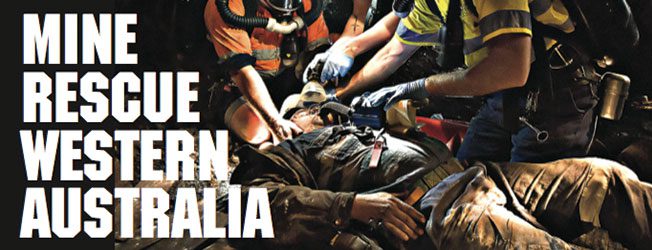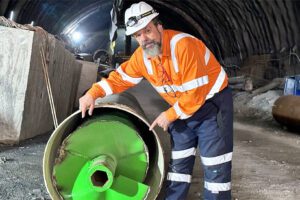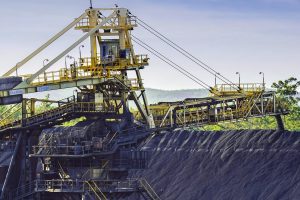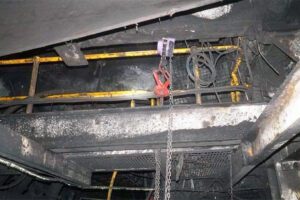A culture of cover-ups, or an industry of continual improvements? Shane Ashish reports on the controversy surrounding the state of mine rescue in Western Australia.
Collaboration of Mines Rescue and Emergency Services is engrained in the mining culture of Queensland, yet in Western Australia the mines are predominantly metalliferous, giving rise to much different conditions than in Queensland. The potential hazards are not deemed to need the scale of manpower as Queensland, therefore there is little obligation to have them.
In Western Australia mettalliferous mines are known to be quite susceptible to pressures because they are located on the igneous rocks and are quite fragile. Therefore an extensive risk management plan still needs to be adopted, however mine safety incidents continue to go un-reported for fear a loss of performance-based incentives.
WA’s Zero Harm Policy and Safety at Work
Early in the year various callers to ABC Local Radio in the Geoff Hutchinson’s Program asked whether the people were committed to ensuring the safety of mining company employees. Most attribute the issues of safety by contractors in WA to the fear of lowering their performance indicators, contrasted to QLD where safety issues within the mines are discussed more openly. A WA mine worker stated, “…we do fear to talk about safety within the mines due to the fear of being intimidated or victimised.” The worker went on to say that, “I am aware that very few people are not scared to raise safety issues because they would lose their performance assessment and their bonus”.
Mines in Western Australia are amongst the most unsafe in the country, according to new data from Safe Work Australia, revealing a culture of cover-ups which can prove deadly. The Sunday Times reported a “culture of cover ups” also reigns on some sites, with workers reluctant to report injuries or accidents for fear of reprimand.
According to The Sunday Times the latest Safe Work Australia figures show more mining workers die in WA than any other state. The data shows from 2007-08 to 2010-11, a total of 16 mining workers died in WA compared to six in Queensland, five in New South Wales and South Australia, and two in Victoria.
While WA has over a third of Australia’s mining workforce it accounts for almost half the deaths in the industry. The SWA data shows a small climb in the rate of fatalities for the WA industry as the total workforce has grown. Previous records show over a six year period from 2003-04 to 2009-10, 25 mining workers died in WA at a rate of over four a year. In the same period 15 workers died in QLD, a rate of over two per year.
The new data shows over five workers a year died in WA from 2007-08 to 2010-11, but QLD’s rate fell slightly to two a year. Worker advocacy groups say employees can be reluctant to report accidents or injuries because some companies link bonuses to lost-time injury rates.
The Need For Mutual Aid Agreement
Mutual aids agreements within Western Australia are known to play a huge role in determining whether people should act in a particular way when an emergency occurs within the mine. In the past there has been no single agreement adopted by the WA and QLD jurisdictions in regards to ensuring mine safety within the mines. The two states have focused on adopting their own frameworks for managing safety within mines, but in reality, having a ‘principal’ regulation that is developed to govern mining nationally could be a solution to ensuring that safety in mines is well regulated. Synchronising the approach of mine safety on a national scale may however cause a
Western Australia has handled the mine safety issue with the appointment of at least 27 new resources safety inspectors to ensure that there is a an increase in the number of people who conduct safety inspection within all the mines across WA. Additionally, the inspector numbers were increased to ensure that all the safety regulation violations which occur are effectively dealt with. It is noted by their own admission, that for any inspector to succeed, “they must be well motivated and given the chance to exploit their passion” in safety of the mines.
The WA Mines and Inspection Act 1994 gives every person that works within the mines the guidelines on how they can report about any incidence or any accidents that occur within the mines. The incident reports are usually recorded and looked into to ensure that what was the cause is taken care off and would not happen again. The data is usually given to the Safety Regulation System online for ease of accessibility.
Once a report has been submitted a supplementary geotechnical report that usually does involve the seismic and fall of ground and is to be submitted within two weeks. Amongst the latest incident reports submitted to the WA mining department, it included; burns from hydrocarbon gas fire in truck air conditioning system, a collusion of a light vehicle with a stationery loader and employee burnt setting up fire scenario. It is of crucial importance to see that instant reporting on occurrences of safety and incidents in mines is crucial for major players in the mine safety areas to ensure that their workers are safe.
Each time a mining disaster occurs within the WA this is usually the time where renewed calls for the safety of the mines occur. For instance in June 2010, Wayne Ross became the ninth mine worker to fall at the BHP’S nickel mine Leinster, and died because his bogger tumbled into a section of the mine. This incident prompted an inquiry in to the incident as well as the safety of other miners.
Legislation on Mines Safety and Inspection in WA
Early in the 1990s there was a drastic change in most of the laws that governed mines safety. Amongst the archaic legislation included the Mines Regulation Act 1895, and the Coal Mines Regulation Act 1946. The fact that for any kind of law to be effective, it needs to adapt to the changes and working environment of workers yearly with the different societal and technological changes. This is based on the fact that Western Australia itself in 2012 has different causes for miner’s safety as compared to those that existed in the 19th and 20th Century. Progressive laws are crucial in ensuring that the miners are well protected as well as the mines adhere to the set standards to ensure safety within the mines.
The main legal framework is the Mines Safety and Inspection Act 1994 commonly known as the “Roben Legislation” that seeks to provide the framework for mines, quarries, as well as any explorations that are conducted within the state. The act does provide for every person responsible for mines safety that they should be in a secure, safe and a healthy environment within the workplace, assistance of the workers in reduction of hazards, protection against risks and ensuring that effective controls and eliminations of any risks are imposed.
In Queensland the two main Acts that govern mine safety are the Coal Mining and Safety and Health Act 1999 and the Mining and Quarrying and Health Act 1999. The Coal act only deals with issues of coals and the other act is mainly concerned with governing other mining activities and operations.
Recently the QLD Mining Minister Sir Hinchliffe Stirling stated that the change in laws governing mine safety stated that anybody working within the mine should work under their own safety management plans. Unlike Western Australia where the safety of mines are undertaken by one particular body, each mine in QLD must have its own safety plans attributed to being amongst the safest in the entire world.
The Way Forward For Mine Safety in WA
Risk management and proper plans to manage any kinds of emergency at the mines are crucial as well as the role played by all individuals involved in the safety of miners is important. Freedom of expression is instrumental in unmasking the unhealthy and hazardous mines, because when workers talk openly about the state of mines, safety inspectors can effectively deal with mine safety issues. Mine safety should not be an issued filled with politics and promises, but is rather pertinent, and requires action and not deception.
Statement From The Chamber of Minerals & Energy of WA
Reports of fatalities in the mining industry fails to recognise that safety in the WA resources sector has improved both in terms of number of fatalities and Lost Time Injury Frequency Rates over the past ten years.
The Chamber of Minerals and Energy of Western Australia (CME) said despite this vast improvement, the industry was far from complacent on the need to make continual improvements.
“While no fatality is acceptable it should be acknowledged it has been over 12 months since our last fatality in the mining sector,” CME Chief Executive Reg Howard-Smith said. “This can only be achieved by everyone working together to keep the focus on safety to ensure this can stretch to two, three, ten, even more years without another occurring.
“Creating a safe workplace cannot be done by companies in isolation, it requires everyone in the workplace to be working together to proactively identify and address safety concerns.
“Resource sector employees have a both a right and a responsibility to report safety hazards. If they don’t, they are not only putting themselves at risk but those they work with. If issues are not resolved in the workplace, they have the right to report them to the regulator.
“CME encourages individuals to do this as we cannot accept poor safety practices in the industry.” Mr Howard-Smith said CME was not aware of any company that does not want their workers to report injuries or hazards.
“It is only through companies being made aware of issues that they can do something about rectifying them before someone gets hurt,” he said. CME also refutes claims made against the autonomy of the mine safety regulator.
“Any allegations the mine safety regulator is controlled or is not independent are simply false and misleading,” Mr Howard-Smith said. CME promotes collaboration between resource companies through a range of health and safety programs including the annual Safety and Health Innovation Conference and Awards and the emergency response skills competition days in both the Goldfields and South-West region.
South West Emergency Response Skills Challenge
Five emergency response teams from South-West resource companies put their skills to the test recently in a competition across a range of emergency scenarios.
Proudly coordinated by The Chamber of Minerals and Energy of Western Australia (CME) the South West Emergency Response Skills Challenge allows teams to use, compare and test their emergency response skills in a controlled environment.
Held over 31 August and 1 September at Newmont Boddington Gold, teams were tasked with realistic scenarios including confined space and hazardous material management, rope rescue, fire fighting, vehicle extraction, first aid and a theory assessment.
CME Director Nicole Roocke said the Challenge was an ideal training exercise. “The resources sector places the highest importance on safety and this event allows companies to evaluate their knowledge and skills against other teams,” Ms Roocke said.
“CME is proud to host these skills challenges and it’s great to see how passionate and dedicated toward safety these companies are. Newmont Boddington Gold as host company certainly went all out to ensure the challenge was a success and our thanks go to all involved including the competing teams, event management personnel, volunteers and organisers who all worked tirelessly.”
The full list of 2012 winners are:
• Overall Best Team Winner: Premier Coal
• Overall ‘Best Team’ Runner-Up: Newmont Boddington Gold
• Team Safety Award: Premier Coal
2nd Place: BHP Billiton Nickel West
• Confined Space Rescue: Premier Coal
2nd Place: BHP Billiton Nickel West
• Hazardous Material Event: Newmont Combined Team
2nd Place: BHP Billiton Nickel West
• Rope Rescue: Premier Coal
2nd Place: BHP Billiton Nickel West
• First Aid: Premier Coal
2nd Place: Newmont Boddington Gold
• Fire Fighting: Premier Coal
Read more Mining Safety News














Add Comment